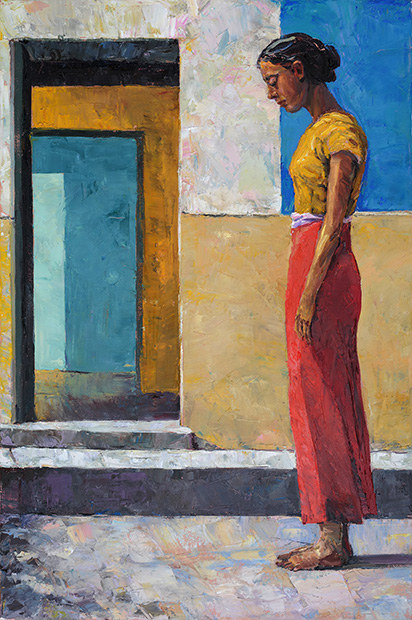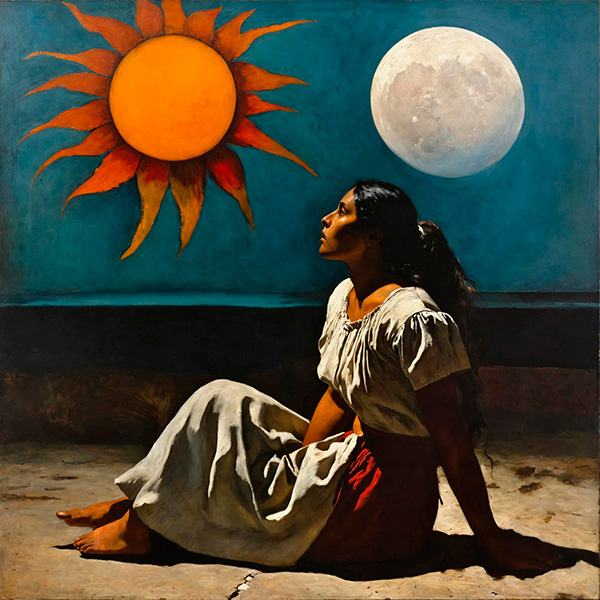My Fairy-Tale Life, by Steven Boone
"Every man's life is a fairy tale written by God's fingers." Hans Christian Andersen
Sunday, October 20, 2024
Embracing The Essence
Sunday, October 13, 2024
A Visit from the Village Veterinarian
Sunday, September 29, 2024
Blossoming
Five years ago, my wife Amy and I made a big life change—we moved to a village in southern Mexico on the outskirts of Oaxaca. We are both artists and made our studio in our home, called Dos Venados, or Two Deer. We wanted to integrate ourselves into our community in a meaningful way, especially with our immediate neighbors, and that’s when the idea of offering art lessons to local children was born.
 |
| Early group picture, 2022 |
Every Sunday, we gather with about eight neighborhood children for a couple of hours of creativity. We provide all the materials—paints, brushes, canvases, sculpture objects—and even refreshments. What started as a fun way to spend time with the kids has blossomed into something much more meaningful. We initially thought the interest might wane as the children grew older, but to our delight, they continue to come back each week, excited for the next project.
 |
| Ebeth, then and now. Watching them grow, not just as budding artists but as individuals, has been a rewarding experience. |
The joy of these Sunday gatherings has made this one of the most fulfilling parts of our life here. We see that our efforts are appreciated. Bonding has occurred. Sometimes a child arrives at our gate with fresh made warm tortillas as a gift. It’s a beautiful reminder that sometimes, the simplest gestures can build the strongest connections.
 |
| Luna, Aram and Pilar. About 1 year ago. |
Sunday, September 15, 2024
An Immersive Cultural Experience
Visiting Abastos Market in Oaxaca, Mexico is a grand adventure⏤an immersive experience in the heart of local culture. As one of the largest and busiest markets in the region, it bursts with vibrant colors, scents, and sounds. Mostly sheltered, taking up about four city blocks, the air is filled with the rich aromas of freshly ground chilies, spices, grilled meats, fish, flowers and herbs. Stalls overflow with everything from handwoven textiles and pottery to exotic fruits and traditional Oaxacan foods like mole, tlayudas, and chapulines (grasshoppers). All types of hardware, household items, clothing, shoes and hats, are sold. The energy is palpable, as vendors call out their offerings, and shoppers negotiate prices. It’s a bustling hub of life, offering a true taste of Oaxacan tradition.
 |
| Woman selling fried chapulines, or grasshoppers |
Amy especially is entranced, stopping often to inspect goods. I stroll through, taking pictures and enjoying the bustling atmosphere. We like to stop along the way for a cool chocolate shake made by a specialty chocolate shop called Mayordomo. Here is a six minute video of the market experience, with music:
Big Mexican markets are sensorial delights of sight, sound, textures, smells . . . . the total package. Our little village, San Pedro Ixtlahuaca, outside Oaxaca city, has its own Tuesday market, where vendors sell fruits and vegetables, homemade foods, flowers, garden plants and other items. Each week I buy fresh cut flowers, fruits and vegetables.
Our home always is adorned with beautiful flowers.
Sunday, September 01, 2024
Blessing of the Animals
Yesterday, Amy was particularly keen on going to the annual blessing of the animals (Bendición de los Animales) at Nuestra Señora de La Merced, a humble church in Oaxaca Centro district. The day is the Catholic feast day of San Ramón Nonato, canonized by Pope Alexander VII in 1657.
We departed from our village under stormy skies to make the 45 minute drive and arrive by 4 PM. At first there were but few people with animals, but steadily more arrived. People carrying cats, variety of dogs in costumes, fish in aquariums, birds . . . all kinds of creatures along with doting owners. The animals behaved, though sometimes excitedly tugging at leashes.
A wonderful litany was spoken (in Spanish so I did not understand most of it). At times the crowd with their animals chimed along in a group recitation. At conclusion the priest and helpers walked around and sprinkled holy water in blessing.
 |
| With her little fish |
Amy and I gleefully engaged and took photos amidst the friendly and unique gathering.
 |
| This pigeon has been with the woman three years, since hatching from an egg. In a priest outfit. |
We went away satisfied, once again thankful to be blessed living in such a vibrant and artistic corner of the world as Oaxaca. We determined that next year we would bring our two dogs.
Sunday, August 25, 2024
A Visual Feast
Sunday, August 11, 2024
Quinceañera for Frida
Last weekend, my wife Amy and I had the honor of attending a quinceañera for Frida, the daughter and granddaughter of our friends and close neighbors here in San Pedro Ixtlahuaca. We were thrilled to be invited as the event photographers, capturing beautiful moments of this special day.
The evening was a vibrant tapestry of music, dance, oratory, and heartfelt tributes to Frida. From the lively tunes played by the band to the choreographed dances by Frida and her court, every moment was filled with joy and celebration. One of the highlights was the "calenda," a traditional parade that entered the hall and added a unique and festive touch to the evening.
Especially, the dancing of Frida and her entourage of young friends was very touching. Such respect and camaraderie, gave a touching poignancy to the evening.
As the night progressed, we ate our fill and our hearts were brimming with the warmth and friendship of the community. We felt a profound sense of belonging, embraced by the kindness and generosity of our friends and neighbors. It was a night we will cherish forever, a testament to the strong bonds we’ve formed in our beloved village of San Pedro Ixtlahuaca.
Congratulations to Frida on her marvelous quinceañera . . . and to her wonderful family.
Sunday, July 28, 2024
Excitement and Spectacle
Despite the weather, we decided to go. The parade was scheduled to start at 5 PM, so we left around 4, planning to arrive at our viewing spot fifteen minutes before the swirling dancers, brass and percussion bands, puppets, and other participants would pass by. It continued to drizzle as we drove, and approaching the Centro district, we got stuck in a traffic jam, barely inching forward. Meanwhile, the parade had already begun. Amy suggested we turn back, thinking it might be a wasted effort. However, we had come this far, so we decided to stay in the slow-moving lines of cars, our windshield wipers slowly slapping time. I resolved to head to where the parade would finish since we would miss the start. The route spans about a mile.
The unusual amount of traffic puzzled us until we realized it must be due to the festival. To our dismay, the police had blocked off some streets as we arrived. Nevertheless, I managed to navigate us to the area where the parade would end. The streets were extremely crowded, making parking a challenge. Eventually, I turned up a little cobblestone street. By this time, dusk was approaching, and the sky was overcast. As I drove slowly forward, I hit an unseen hole. Crunch! The car lurched with a terrible noise. This was worse than the usual for the often rough streets and sidewalks. We parked about twenty feet further along. I was upset, Amy was disheartened, and it was still sprinkling. But we needed to find the parade.We walked about five blocks, sometimes sharing our one umbrella. The rain wasn't heavy, so I accepted getting slightly wet. A huge crowd had gathered at the corner where the parade would soon arrive and make a turn. We could get no closer than about four people back, blocked by a solid mass of humanity. Both sides of the festive streets were filled with families, some children perched atop their father's shoulders. Plenty of umbrellas were open and held aloft.
When the parade arrived, the atmosphere exploded with jubilation. Fireworks burst overhead, bands played energetically, dancers swirled in native costumes, and women with long black braids danced gracefully. Revelers shouted, "¡Viva Oaxaca!" Candy was thrown into the crowd. From behind people, I could barely see, and Amy even less, but the excitement and spectacle were palpable. Looking behind us, an old woman, much shorter than Amy looked helplessly. And there were more people behind her. We stayed for about twenty minutes before deciding to leave.
One of our favorite restaurants was nearby, so we ended up there for dinner before heading home. Thankfully, our car seemed to have weathered the hit. In the end, we felt peculiarly satisfied and agreed that next year, we would arrive much earlier.
Sunday, July 14, 2024
Vibrant Culture of Oaxaca
Living in our rural village of San Pedro Ixtlahuaca, my wife Amy and I are privileged to experience the vibrant culture of nearby Oaxaca in its most authentic form. Every July, we eagerly anticipate the Guelaguetza festivities, an annual festival celebrated in Oaxaca, Mexico, that showcases the rich cultural diversity of the region. Here are the key aspects of the Guelaguetza festivities:
1. Timing and Location: The festival takes place on the last two Mondays of July in Oaxaca City and surrounding areas. The main events are held at the Guelaguetza Auditorium on Cerro del Fortín, a hill overlooking the city.
2. Cultural Significance: "Guelaguetza" means "offering" or "reciprocal exchange of gifts" in Zapotec, reflecting the festival's emphasis on community sharing and mutual interdependence.
3. Historical Roots: The festival has origins dating back over 3,000 years, initially as a celebration of the Oaxacan corn goddess. It later incorporated Catholic elements after Spanish colonization.
4. Regional Representation: Delegations from Oaxaca's eight culturally diverse regions participate, showcasing their unique traditions.
5. Performances: The festival features traditional dances, music, and costumes specific to each region. Performers often distribute gifts to the audience, such as fruit, baskets, candy, or local goods.
6. Parades: Colorful parades called "calendas" are an integral part of the festivities, featuring dancers, singers, and musicians.
7. Food and Drink: The festival celebrates Oaxacan cuisine, including specialties like mole and mezcal.
8. Artisanal Crafts: A market (mercado) showcases handmade items from Oaxaca, including traditional apparel and crafts.
9. Additional Events: The celebration includes side events such as the performance of "Princess Donaji," an epic pre-Hispanic theatrical presentation.
10. Tourist Attraction: While the Guelaguetza has become a significant tourist draw, it remains deeply important for preserving and celebrating the indigenous cultures of Oaxaca.
The dancers are a sight to behold. Adorned in native costumes, they step and twirl with grace and precision, their movements telling stories passed down through generations. Each region of Oaxaca showcases its unique heritage through these performances, from the vibrant dresses of the Isthmus of Tehuantepec to the feathered headdresses of the Mixtec dancers. The vivid colors and intricate designs of their costumes are mesmerizing, a testament to the rich cultural tapestry of our region. Often women dance and twirl with baskets of flowers or fruit on their head.
As the sun sets, festivities take on a magical glow. Street vendors offer an array of delicious Oaxacan treats, from tlayudas to chapulines, and we indulge in these local delicacies while soaking in the festive atmosphere. A sense of community is overwhelming, as locals and visitors alike come together to celebrate and honor Oaxaca's heritage.
Driving back to San Pedro Ixtlahuaca, we felt a deep sense of satisfaction, joy and pride. Guelaguetza is more than just a festival; it is a celebration of life, culture, and unity. It reminds us of the beauty of our traditions and the importance of coming together as a community.
Every year, this journey reaffirms our love for Oaxaca and its vibrant culture. We return home with hearts full of memories, eagerly awaiting the next Guelaguetza and the joy it will undoubtedly bring.
I will be sharing more, as the main, big parades have not begun yet.
Sunday, July 07, 2024
And So We Are Home.

 |
| View from our roof, after a recent rain. |
Sunday, April 28, 2024
Inspiration is Key
It's been about six months since I delved headfirst into the realm of creating images using artificial intelligence, and I must say, the journey has been nothing short of captivating. From the very beginning, I was spellbound by the incredible abilities and swiftness with which AI can bring imagery to life.
 |
| Oaxaca Passages, oil on canvas, 40 x 70 cm, April 2024 |











































